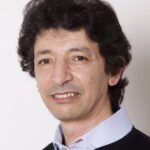Link to Pubmed [PMID] – 9853969
Link to HAL – pasteur-04036432
Link to DOI – 10.1002/(SICI)1097-0177(199812)213:4<486::AID-AJA13>3.0.CO;2-L
Developmental Dynamics, 1998, 213 (4), pp.486-499. <a target="_blank" href="https://dx.doi.org/10.1002/(SICI)1097-0177(199812)213:43.0.CO;2-L">⟨10.1002/(SICI)1097-0177(199812)213:43.0.CO;2-L⟩
Branchio-Oto-Renal (BOR) syndrome is an autosomal dominant, early developmental defect characterised by varying combinations of branchial (fistulas, sinuses, and cysts), outer, middle and inner ear, and renal anomalies. The gene underlying this syndrome, EYA1, is homologous to the Drosophila developmental gene eyes absent which encodes a transcriptional co-activator required for eye specification. We report here the temporal and spatial pattern of expression of the murine homologue, Eya1, throughout ear and kidney development in relation to the anomalies of BOR syndrome. The expression of Eya1 in the branchial arch apparatus (namely in the 2nd, 3rd, and 4th branchial clefts and pharyngeal pouches) at embryonic day (E)10.5, can be correlated with the branchial fistulas, sinuses, and cysts but not with the outer and middle ear anomalies. In contrast, Eya1 is expressed during the slightly more advanced stage of outer and middle ear morphogenesis at E13.5, in the mesenchyme adjacent to the first branchial cleft (the cleft will give rise to the external auditory canal and the surrounding mesenchyme to the auricular hillocks) and surrounding the primordia of the middle ear ossicles, and in the epithelium of the tubotympanic recess (the future tympanic cavity). During early inner ear development, Eya1 is expressed in the ventromedial wall of the otic vesicle (the site of the future sensory epithelia), in the statoacoustic ganglion, and in the periotic mesenchyme, consistent with the cochlear anomalies and sensorineural hearing loss of BOR syndrome. Subsequently, Eya1 expression is observed in the differentiating hair and supporting cells of the sensory epithelia, as well as in the associated ganglia, and persists after differentiation has taken place. This suggests that, in addition to a role in the morphogenetic process, Eya1 could also be implicated in the differentiation and/or survival of these inner ear cell populations. Finally, Eya1 expression in the condensing mesenchymal cells of the kidney is consistent with the excretory and collecting system anomalies of BOR syndrome. From the comparison of the Eya1 and Pax2 expression patterns during ear and kidney development, a contribution of these two genes to the same regulatory pathway can only be suggested in the mesenchymal-epithelial transition directing renal tubule formation.

